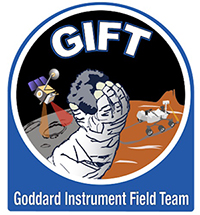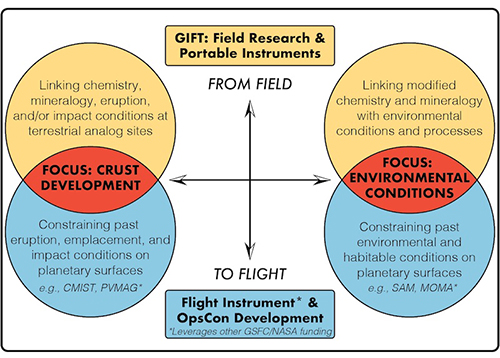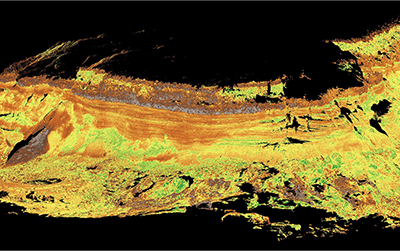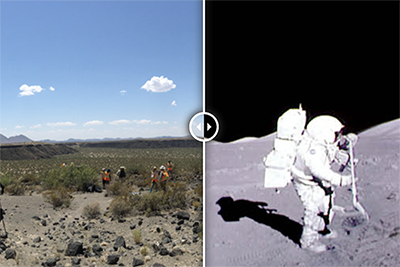

The Goddard Instrument Field Team (GIFT) is an internal scientist funding model (ISFM) work package at NASA Goddard Space Flight Center and Ames Research Center. GIFT enables interdisciplinary studies of planetary crustal development, modification, and potential to host habitable environments. GIFT science investigations research the development of planetary crusts (e.g., by magmatic and impact cratering processes) and environmental conditions that have acted on these crustal materials. GIFT scientists collect data during field expeditions to planetary analog sites. At these sites, GIFT explores interdisciplinary science questions and incorporates testing of science instruments comparable to instruments that are deployable on other planetary surfaces.

For the last decade, NASA's Goddard Space Flight Center has led and supported planetary analog field science campaigns focused on advancing fundamental research and testing new instrument technologies. Sustained investment (ROSES R&A, internal/strategic funding, and mission/project support) has driven integration between geology and astrobiology research efforts, developed a suite of field portable instruments, and supported testing of new concepts of operation. GIFT provides the agency and the science community with routine opportunities for partnership studies of planetary analog terrains and environments, enabling ground truth testing of research hypotheses developed from mission observations. The capabilities developed within GIFT are a resource unique to NASA.
GIFT Co-Leads: Jacob Richardson, Bethany Theiling
Data Management: David Hollibaugh Baker
Logistics and Public Engagement: Caela Barry
Past GIFT Co-Leads: Amy McAdam, Kelsey Young, Jacob Bleacher
Heather Graham (Field Lead)
Patrick Whelley (Field Lead)
David Hollibaugh Baker (Deputy Field Lead)
Christine Knudson (Deputy Field Lead)

Welcome to GIFT's world! This video gives an overview of the Goddard Instrument Field Team's work, including footage of field locations and equipment.
The following resources are jointly developed and maintained by the Goddard Instrument Field Team (GIFT) and two nodes of the Solar System Exploration Research Virtual Institute (SSERVI): Geophysical Exploration Of the Dynamics and Evolution of the Solar System (GEODES) and Remote, In-Situ, and Synchrotron Studies for Science and Exploration (RISE2)
These are living documents. Below are sample versions of each resource, last updated December 2024:
Field Safety Plans are site- and task-specific. Following are two examples of safety plans created for field work at distinct locations. For general recommendations, please see (1).
Example of a safety plan written for field work in a remote location outside of the United States:
Example of a safety plan including wildfire considerations and protocol for working in caves:
Acknowledgments:
Earlier versions of the Joint Field Work Code of Conduct were written and field-tested by the Goddard Instrument Field Team. The current revision also draws inspiration from the Codes of Conduct laid out by the Western Wildfire Experiment for Cloud Chemistry, Aerosol Absorption, and Nitrogen (WE-CAN) and the Association of Polar Early Career Scientists (APECS).
Our Field Bill of Rights is inspired by a similar document from the Association of Polar Early Career Scientists.
The safety policies and strategies in the Field Safety Plans draw on our field leads’ years of professional training and experience. The authors would like to acknowledge the University at Buffalo and Arizona State University Geology Field Camps, the National Outdoor Leadership School, The Red Cross and the Central Massachusetts Search and Rescue Team for inspiring safety in the field.
(1) Building Safer and More Inclusive Field Experiences in Support of Planetary Science, Richardson, J.A. et al. (2020) NASEM Decadal Survey, White Paper #447
(2) Field Expedition Codes of Conduct for Increasing Safety and Inclusivity. Richardson, J.A. et al. (2020) Workshop on Terrestrial Analogs for Planetary Exploration, Abstract #8113.
(3) Developing Community Resources to Promote Safety and Inclusivity in Field Work. Barry, C. et al. (2022) Lunar and Planetary Science Conference, Abstract #2811.
(4) Strategies for Increasing Safety and Inclusivity in the Field: Five Years of RISE2 and GEODES Best Practices. Richardson, J.A. et. al. (2024) NASA Exploration Science Forum.

GIFT is partnering with the US Geological Survey to archive community-valued field data at ScienceBase.gov: GIFT Data Archive at USGS PlanetBase.
Towards a Terrestrial Analogs Data Portal: Use Cases and Requirements. Baker, D.M.H. et al. (2021) 5th Planetary Data and PSIDA, Abstract #2549.

Our planet isn't the only place with volcanoes, impact craters, quakes, and erosion. Studying Earth helps us understand other worlds better, too.
Similar environments on different worlds are called planetary analogs. Studying planetary analogs is a powerful way to make sense of our solar system.
GIFT scientists support NASA planetary analog science communication by volunteering their time as subject matter experts.
NASA's Planetary Analogs Homepage
Interactive Gallery: Compare Worlds Side-By-Side
Into the Field with NASA: Valley of Ten Thousand Smokes
Under the Ash: Glacier Science at a Volcano
NASA's Planetary Analogs Website: Comparing Landscapes Throughout our Solar System. Barry, C. et al. (2021) Workshop on Terrestrial Analogs for Planetary Exploration, Abstract #2595.